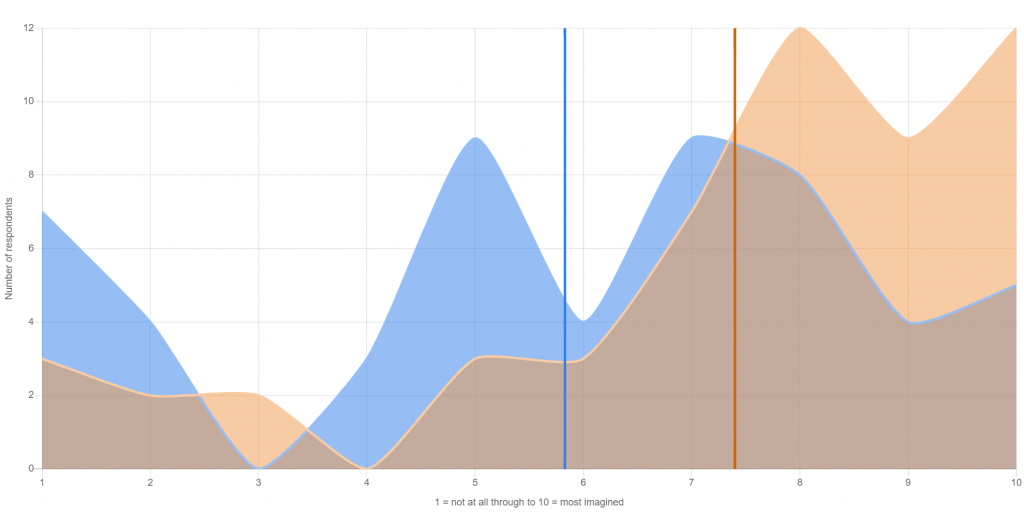Objective: Agency and voice to be enabled
Outcome: Agency and voice is enabled
Measure: Agency and voice enabled
Short Description
By agency and voice enabled we mean the freedom to express one’s opinions publicly and they are welcomed, respected and valued.
Full description and underpinning theory
Full description
This outcome is about how engagement in cultural activity can contribute to an individual’s agency and voice in the community. By agency and voice, we mean the ability and freedom an individual has to express their opinions (about the world)in public and act on those opinions. To do this an individual should be confident that it is safe to express their opinions, their voice will be heard, and their ideas are welcomed. Having agency and voice is important for civic engagement as people are more likely to be involved if they feel they can influence change.
Theory underpinning this outcome
Agency can be described as having the freedom to act deliberately, independently and with choice (Lister, 2004). Having agency and voice is important for civic engagement as believing that your voice and actions can effect community change is a factor in people’s participation in civic action (Watts & Guessous, 2006). Young people are more likely to be politically involved and engaged in the community if they believe that they can influence change (Hope & Jagers, 2014; Leath & Chavous, 2017). This can also have an effect on the individual wellbeing with civic engagement linked to greater self-esteem and social skills (Sherrod, Torney‐Purta, & Flanagan, 2010;) as well as encouraging feelings of belonging (Flanagan & Levine, 2010). Programs designed to promote agency in young girls in sub-Saharan Africa have shown that providing safe spaces for girls to express their opinions, take risks and promote their own interests have resulted in increased well-being (Dettori & Rao Gupta, 2018)
Evidence that this outcome occurs
Young adults who had intensive arts experiences in high school are more likely to show civic-minded behavior than young adults who did not. They take an interest in current affairs, as evidenced by comparatively high levels of volunteering, voting, and engagement with local or school politics. In many cases, this difference appears in both low and high-SES groups (Catterill, 2012).
Respondents who reported both creative and attendance based arts activity were six times as likely to do volunteer or charity work in their community, although this analysis does not explain causality (National Endowment for the Arts, 2008).
Activities contributing to this outcome
Activities
As of April 2021, there were 13 activities in Takso selecting this outcome with 3 completed and evaluated. Types of activities undertaken to achieve this outcome include:
- Gathering, celebration or ceremony,
- Research and development,
- Sector development.
Results
Over the 3 completed activities that addressed this outcome, 58 people responded to the evaluation question. On a scale of 1 to 10, with 1 being not at all and 10 the most imaginable, respondents reported an average pre activity level of 5.8 for this outcome and a post activity average of 7.4.
Agency and voice enabled
2 Activities / 250 responses / Pre activity average 5.8 / Post activity average 7.4

Evaluation measure
Measure
Agency and voice
References
Animating Democracy (n.d). Planning & Designing of Arts-Based Civic Engagement Projects. Washington: Americans for the Arts.
Dettori, E. & Rao Gupta, G. (2018), Gender Equity and the SDGs: Collective Impact for Change. In Lansford, J. E. & Banati, P (2018) Handbook of Adolescent Development Research and its Impact on Global Policy. Oxford University Press, USA
Flanagan, C., & Levine, P. (2010). Civic engagement and the transition to adulthood. The Future of Children, 20(1), 159-179.
Hope, E. C., & Jagers, R. J. (2014). The role of sociopolitical attitudes and civic education in the civic engagement of black youth. Journal of Research on Adolescence, 24( 3), 460– 470.
“We really protested” : The Influence of Sociopolitical Beliefs, Political Self-efficacy, and Campus Racial Climate on Civic Engagement among Black College Students attending Predominantly White Institutions. (2017). The Journal of Negro Education, 86(3), 220-237.
Moore, S., Hope, E., Eisman, A., & Zimmerman, M. (2016). Predictors of Civic Engagement Among Highly Involved Young Adults: Exploring the relationship between agency systems and worldview. Journal of Community Psychology, 44(7), 888-903.
Sherrod, L. R., Torney-Purta, J., & Flanagan, C. A. (Eds.). (2010). Handbook of research on civic engagement in youth. John Wiley & Sons Inc
Watts, R. J., & Guessous, O. (2006). Beyond resistance: Youth activism and community change. In G. Dimitriadis (Ed.), Sociopolitical development: The missing link in research and policy on adolescents (pp. 59– 80). New York: Routledge.

